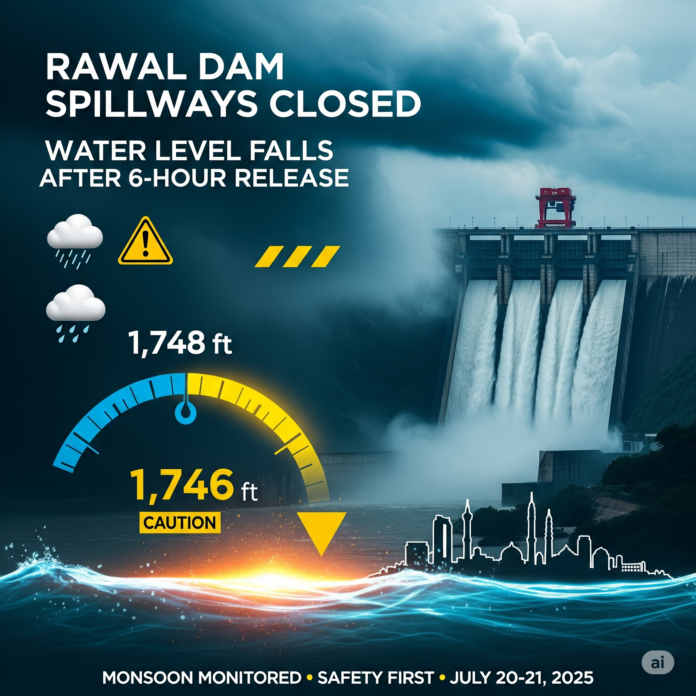
As monsoon rains continued to pour over Islamabad and its surrounding hills, water levels at Rawal Dam rose sharply on Sunday morning—prompting local authorities to take swift and measured action. For more than six hours, the spillways of Rawal Dam were opened to safely release the rising water and avoid potential overflow, protecting both the dam and downstream communities.
💡 A Race Against Rising Waters
Nature doesn’t wait—and neither did the Islamabad district administration. With rainfall feeding into the dam’s catchment area overnight, the water level surged to 1,748 feet, just shy of the dam’s full capacity of 1,752 feet.
To prevent the situation from becoming dangerous, authorities made the call early: release the excess water through the spillways.
This wasn’t a decision taken lightly—it was part of a well-rehearsed emergency protocol. Still, executing it required real-time coordination, careful monitoring, and boots on the ground.
⏳ Six Hours of Careful Water Flow Management
The spillways remained open for around six and a half hours, allowing a gradual, controlled release of water. By the end of the operation, the reservoir’s level had dropped to 1,746 feet, easing pressure and bringing the dam back into its safe operational range.
Once the level stabilized, the spillways were promptly closed.
🚨 Behind the Scenes: A Team Effort to Keep Everyone Safe
The response was anything but ordinary. Emergency crews, administrative officials, and technical teams were deployed across Islamabad to keep an eye on sensitive areas like riverbanks, bridges, low-lying neighborhoods, and stormwater drains.
The Assistant Commissioner of Nilore subdivision personally supervised the situation on the ground. Medical staff, police officers, and engineers were all on standby, ready to jump in if the water caused even the slightest disruption.
Thanks to their collective effort, the release went off smoothly—with no damage, no flooding, and no panic.
🧠 Why Spillways Matter (And What They Actually Do)
Think of spillways as the pressure valves of a dam. When water levels threaten to overflow, spillways are opened to release the excess in a way that won’t harm nearby communities. In the case of Rawal Dam, it’s a crucial safeguard—especially during the unpredictable monsoon season.
The dam itself is not just any reservoir. It’s a vital source of water for Islamabad and Rawalpindi, serving homes, businesses, and municipal infrastructure. Keeping it in good working order is critical—not just for water supply but also for flood protection during heavy rains.
🗓️ What’s Next: Another Discharge Expected Monday Morning
Authorities have already announced a second round of water release from Rawal Dam, expected to begin at 6:00 AM on Monday (July 22) and last for about five hours.
The move is proactive, as forecasters predict more rainfall over the catchment in the coming days. This planned release aims to create enough buffer capacity within the dam to handle incoming rain without having to rush emergency measures later.
📣 Important Advice for the Public
If you live near the Korang River, Rawal Lake, or in any low-lying areas, here’s what officials want you to know:
- Avoid fishing, swimming, or boating in and around the dam while spillways are open.
- Keep a safe distance from stream banks and nullahs.
- Move livestock and important items to higher ground if you’re near waterways.
- Follow updates from PDMA (Provincial Disaster Management Authority) and NDMA (National Disaster Management Authority) closely.
- Call Rescue 1122 immediately if you spot any unusual water activity or flooding.
👏 A Job Well Done — But Stay Alert
This operation was a textbook example of what proactive governance looks like. Officials didn’t wait for trouble to arrive—they acted ahead of time, prioritized public safety, and kept Islamabad safe during one of the busiest weeks of monsoon season.
Still, the rains haven’t stopped, and weather patterns remain unpredictable. While the worst was avoided this weekend, authorities are urging the public to stay cautious and report anything unusual.
📘 A Quick Look at Rawal Dam
- Location: Islamabad, Pakistan
- Commissioned: 1962
- Primary function: Drinking water supply + flood control
- Capacity: 47,500 acre-feet
- Main inflow: Korang River and other seasonal streams
💬 Final Word: A City Prepared, A Crisis Averted
In an era where extreme weather is becoming more common, it’s comforting to know that preparedness and teamwork can still make a difference. The Rawal Dam spillway operation was more than just a technical procedure—it was a real-time demonstration of what it takes to protect a capital city from nature’s unpredictability.
Let’s stay informed, stay safe, and stay thankful to the people working behind the scenes—quietly doing their jobs while the rest of us go about our day, dry and undisturbed.


